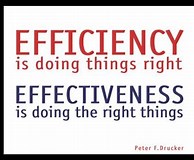Feeling swamped running your small business? Learn what efficiency in business really means, how it reduces chaos, and how targeted tasks can save your sanity (and schedule).
If you’ve ever looked at your overflowing to-do list and thought, “There has to be a better way,” you’re not alone.
I used to feel like I was running on a hamster wheel—constantly busy, but somehow not moving the needle. Meetings, emails, fire drills… rinse and repeat. Until one day, during a 9 p.m. spreadsheet meltdown, I finally asked myself the golden question:
“What is efficiency in business, really?”
Boosting business efficiency can feel like a huge challenge, but breaking things down into clear, actionable tasks make progress much more manageable. The solution is not about doing more.
It’s about doing what matters, better and faster. And as a small business owner, getting that part right? That’s your ticket out of chaos.
Over the years, I’ve worked with teams of all sizes and seen firsthand how small changes can lead to noticeable improvements. Let’s break it down, with lessons I wish I’d learned sooner.
What Is Efficiency in Business? Let’s Cut Through the Fluff
At its core, what is efficiency in business? It’s the ability to achieve maximum output with the least amount of wasted time, effort, or resources.
Sounds fancy, but here’s how I explain it to my fellow coffee-fueled entrepreneur friends:
Efficiency = Doing the right things, in the right way, at the right time.
When you get that equation right, you’re not just working—you’re working smart. That’s where the magic happens.
5 Building Blocks of Efficiency Target Chaos

Let’s make it practical. Here are five key areas where boosting efficiency actually moves the needle and eliminates chaos:
1. Simplyfying Workflows
If your process takes 10 steps when it could take 4, you’re wasting time (and patience). Use business automation and tools to streamline.
Cut out steps that add no value (e.g. redundant checklists). Map out who does what and when, using visual tools like flowcharts or apps such as Trello.
Example: Use templates for client onboarding to create time. What used to take 2 hours will now only take you about 20 minutes.
2. Time Management
Time’s the one thing we never get back. Track where yours goes. Then fix the leaks. Try This: Use a time tracking app for a week. You might be shocked at where your hours disappear.
There was a time I thought multitasking was my superpower. Spoiler alert: it wasn’t! I would jump from client calls to social posts to invoice reminders, and by day’s end, I’d feel accomplished… but nothing actually got done.
Then I started using targeted tasks—small, specific actions tied to key goals. That one tweak? It changed everything. Getting really efficient often means focusing on small, repeatable tasks that clear the way for bigger changes. Here are some focus areas and practical steps that have worked for me and others:
- Setting and Tracking Goals: Use the SMART method (Specific, Measurable, Achievable, Relevant, Timebound) to set goals that everyone understands. Tools like Asana or Google Sheets make it easy to track progress together.
- Batching tasks – Answer emails from 9–9:30 AM. No peeking before.
- Using a prioritization matrix – Urgent vs. important? Eisenhower was definitely on to something with that matrix!.
By doing these, you begin to tap into real operational efficiency—and suddenly, your workday will not feel like you are juggling flaming swords.
3. Reducing Waste
Whether it’s unused subscriptions or overstocked inventory, waste is a silent profit killer of cost-effective operations.
What Worked for Me: I did a monthly “money leak audit.” Found $200/month in tools I never used. Cancelled them all and it felt great!
4. Smart Team Management
An efficient business runs on clear communication and smart delegation – effective team management. Micromanaging? Nope. That’ll sink you faster than a broken rudder.
- Streamline Communication: Make sure everyone knows the best way to reach each other. Use digital tools like Slack or Teams, but set clear guidelines. Regular team check-ins help too. When communication is clear, projects move much faster with fewer mistakes.
- Digital File Management: Keeping digital files organized saves time searching and reduces frustration. Creating a simple folder structure everyone can access, and agree on easy to follow naming rules.
- Delegating smart – If someone else can do it 80% as well, pass it on.
Tip: Use shared checklists and weekly 10-minute huddles. Keep everyone on the same page without drowning in meetings to increase your small business productivity.
5. Continuous Improvement
You don’t fix efficiency once—it’s a habit, not a one-time event. Continuous improvement is a MUST!
What I Do Now: I block off 30 minutes every Friday for a business check-in. What worked? What didn’t? Where’s the lag? These are efficiency best practices.
Build Your Business’s Efficiency Toolkit

The right tools and systems can help teams work in sync. Choosing what fits best might depend on your field, but nearly every workplace can benefit from a few key solutions:
- Project Management Software: I’ve tried tools like Monday.com, Asana, and Notion. These make it much easier to assign tasks, set deadlines, and keep track of details. Even a small team can stay organized with these systems.
- Collaboration Platforms: Using file sharing and realtime editing apps like Google Drive or Microsoft 365 helps avoid duplicate work. This also smooths the way for handoffs between people and departments.
- Time Management Tools: Calendar apps, reminder tools, and basic time trackers can help everyone see how much time tasks actually take. This helps set realistic deadlines and reduce wasted hours.
- Automation: Simple workflows, like using Zapier to move data between apps or having automatic email replies, can reduce repetitive, lowvalue work. Even a few automated steps can free people up for more meaningful tasks.
Step By Step Guide To Make Your Organization More Efficient
Building efficiency is a process, and it helps to start with small wins. Here’s a sequence that I often recommend:
- Spot Bottlenecks: Ask the team where they feel work slows down or gets stuck. Sometimes just one question will highlight a big issue.
- Document Key Processes: Write down every step of your regular tasks, from start to finish. It’s amazing how often simple mistakes come from hidden or forgotten steps.
- Choose Easy Fixes First: Before overhauling systems, pick one or two small changes to try, for example, a better folder structure or daily checkin meetings.
- Train and Support Your Team: Whenever you roll out a new tool, take time to help everyone understand it. In my experience, even a 30minute training session can reduce confusion and give a boost to buyin.
- Review Regularly: Set a reminder to check how new systems are working after 12 months. Get honest feedback, and be ready to adjust if needed.
Even little changes, like tweaking the daily agenda or using keyboard shortcuts, can lead to steady improvement over time.
The Hidden Cost of Inefficiency
If you’re still wondering, what is efficiency in business, consider this:
Every minute wasted is money left on the table.
I once lost a client because I missed a deadline—something that could’ve been avoided if I’d had a better strategic planning system in place. That one dropped ball cost me $1,200/month.
So yes, this stuff matters!
Common Challenges That Make Organizations Less Efficient (And What to Do)
No workplace is perfect, and I’ve seen the same issues pop up again and again. Recognizing them early helps avoid bigger headaches down the line.
- Poor Communication: Unclear emails, mixedup instructions, or missed meetings can leave people confused. Setting rules for how and when to communicate helps a lot.
- Information Overload: Too many notifications, newsletters, or chat messages make it hard to focus. Encourage the team to mute channels that aren’t needed, and help them set boundaries.
- Resistance to Change: Sometimes, habits are the biggest barrier. Explaining the “why” behind a new system and showing early wins can help get more people onboard.
- Duplication of Work: When people don’t know what others are doing, they might repeat efforts. A shared project board or weekly summary helps keep everyone in the loop.
- Messy Digital Files: Having five versions of the same document wastes time. Agree on a clear naming convention and put someone in charge of regular cleanups.
One Example: Tackling Messy Files
I worked with a company that had years’ worth of unorganized folders and files. People spent ages looking for the right version. We formed a small team to design a simple folder system and delete outdated files.
The team noticed less confusion within a week, and productivity improved just by tidying up.
Where Tangible Efficiency Shows Up in Your Business Operations
Changes like these translate into real benefits across all kinds of organizations. I’ve seen nonprofit teams use shared calendars to plan fundraisers, leaving them more time for outreach. Small businesses often grow faster when they automate basic bookkeeping or customer follow-up.
Even in large companies, simple habits—such as ending meetings on time—set a tone that values everyone’s time. The core idea is to keep finding ways to do things simpler, faster, and clearer.
- Client Service: Organized onboarding packets let customers get started quickly, leading to fewer questions and happier clients.
- Inventory Management: Digital checklists mean stock gets reordered on time, avoiding both shortages and overordering.
- Remote Work: When teams agree on communication channels and file storage, everyone can stay connected without constant back and forth.
Conclusion: Ditch the Chaos, Keep the Hustle
So, what is efficiency in business? It’s your secret weapon against burnout. It’s how you take back your time, your sanity, and maybe even your weekends.
Whether you’re solo or managing a small team, targeted tasks, simple systems, and regular check-ins can help you boost work efficiency, improve profits, and actually enjoy running your business again.
Trust me—once you stop chasing chaos and start focusing on the right stuff, everything changes.
Need help spotting the time-wasters in your business? Or want a shortcut to build your own lean business strategies? BCINC has got templates, tips, and caffeinated pep talks—just call or schedule time TODAY!.
What’s one inefficient habit you’re ready to ditch today?
Need Help? Contact BCINC for Assistance Now!Related Articles
- Remove Chaos in Business. How to Use Visionary Planning
- What Causes Chaos in Business operations? – Time to Stop It
- Create Business Systems – Learn How to Move From Chaos to Clarity
FAQs for What is Efficiency in Business
What is efficiency in business in simple terms?
It means getting the most done with the least wasted time, energy, or money. It’s about working smart—not just hard.
Why is efficiency important in a small business?
Because small businesses have limited resources. Efficiency helps you stretch what you have—time, people, and money—to compete and grow sustainably.
How can I measure efficiency in my business?
Use performance metrics like time-to-completion, cost-per-task, or ROI on projects. Also, watch for signs: Are deadlines being met? Is your team overwhelmed?
What’s the difference between efficiency and effectiveness?
Efficiency is doing things right. Effectiveness is doing the right things. You need both for long-term success.
How can I keep up momentum after making some efficiency improvements?
Check in regularly, ask for feedback, and keep the conversation open. Stay flexible so you can adjust to what works best as your team or business grows.


Great breakdown of efficiency in business! Effective business management is key to reducing chaos and driving results. Learn how to navigate its complexities at https://echelonfront.com/is-business-management-hard-navigating-its-complexities/!
Thanks for the comment!